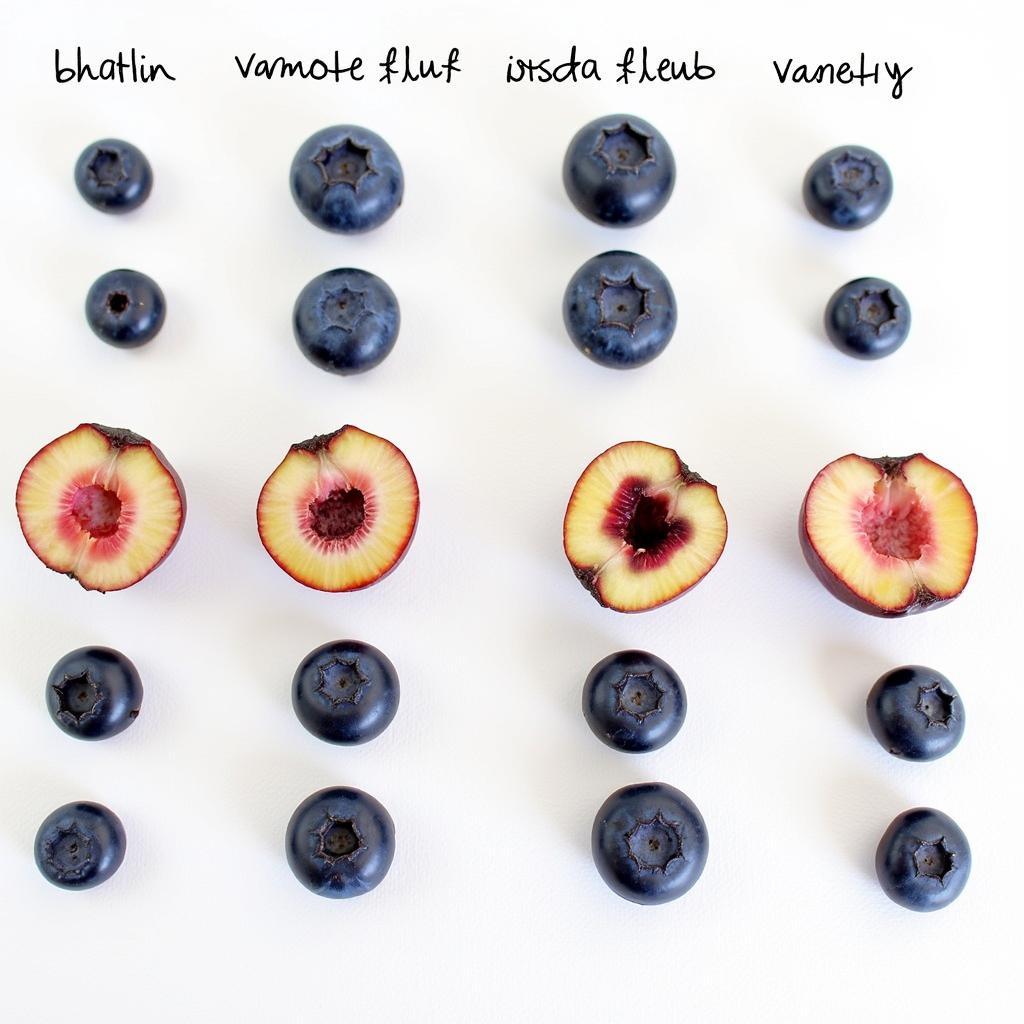Ever bitten into a blueberry and been surprised by the color inside? You’re not alone! Many people associate blueberries with their deep blue exterior, but the inside holds a different secret. So, what color are blueberries inside? Let’s dive into the vibrant world of this superfood and uncover the truth about its inner hue.
Exploring the Inside of a Blueberry
While the skin of a blueberry boasts a beautiful, dark blue color, the inside tells a different story. The flesh of a blueberry is typically a pale greenish-white, sometimes with a hint of purple or light blue, especially near the skin. This lighter shade is a stark contrast to the outer skin, making for a surprising pop of color when you bite into one.
Why the Color Difference?
The contrasting colors between the blueberry’s exterior and interior are due to different pigments. Anthocyanins, powerful antioxidants, are responsible for the rich blue hue of the skin. These pigments are concentrated in the outer layers of the fruit. The inner flesh, however, contains fewer anthocyanins, resulting in the lighter color.
The Role of Anthocyanins
Anthocyanins are not just responsible for the beautiful color; they offer numerous health benefits. These pigments have antioxidant and anti-inflammatory properties, contributing to the blueberry’s superfood status. They are also believed to support heart health, brain function, and even protect against certain cancers.
Factors Affecting Inside Color Variation
While generally pale greenish-white, the inside color of blueberries can vary slightly. Factors such as ripeness, variety, and growing conditions can influence the intensity of the inner hue. For instance, slightly underripe berries might have a more pronounced green tint, while overripe berries may exhibit a deeper purple hue inside.
Ripeness and Variety
The ripeness of a blueberry plays a significant role in its inner color. A perfectly ripe blueberry will have a lighter, almost translucent greenish-white inside. Different blueberry varieties, however, can also exhibit subtle variations in their inner coloration, ranging from a pale green to a light blueish-purple.
 Different blueberry varieties showing varying inside colors
Different blueberry varieties showing varying inside colors
What Does the Inside Color Tell Us?
While the inside color might not be as visually appealing as the deep blue exterior, it can offer clues about the berry’s ripeness and overall quality. A vibrant, pale greenish-white interior is generally a good sign of a fresh, ripe blueberry. However, a brownish or dull inside can indicate the berry is overripe or even starting to spoil.
“The inside color of a blueberry is a subtle but important indicator of its quality,” says renowned food scientist, Dr. Amelia Carter. “A healthy, ripe berry will have a bright, pale interior.”
The Nutritional Value Remains
Regardless of subtle variations in the inner shade, the nutritional benefits of blueberries remain consistent. Whether the inside leans slightly more towards green or purple, the blueberry is packed with vitamins, minerals, and antioxidants. So, don’t let the inside color deter you from enjoying this delicious and nutritious fruit.
“Don’t judge a blueberry by its cover, or in this case, its inside!” adds Dr. Carter. “The true value lies in its rich nutritional profile.”
Conclusion: Unveiling the Inside Story
So, what color are blueberries inside? The answer is a pale greenish-white, often with hints of purple or light blue, especially close to the skin. While different from the deep blue exterior, this inner color is perfectly normal and doesn’t detract from the blueberry’s incredible nutritional value. Next time you enjoy a handful of these tiny superfoods, take a moment to appreciate the fascinating contrast between their outer and inner beauty. Remember, if you ever need help navigating the world of color, Color Box Hanoi is here to help.
FAQ
-
Are blueberries with a purple inside bad? Not necessarily. A slight purple tinge can be normal, especially near the skin or in certain varieties. However, a deep, dark purple inside can indicate overripeness.
-
Why are blueberries blue on the outside? The blue color is due to anthocyanins, powerful antioxidants that offer numerous health benefits.
-
Do all blueberry varieties have the same inside color? While generally pale greenish-white, the exact shade can vary slightly between varieties.
-
Does the inside color affect the taste of blueberries? No, the inside color does not significantly impact the taste.
-
Can I eat blueberries with a slightly green inside? Yes, a slightly green inside is a sign of ripeness, especially in certain varieties.
-
What does a brown inside indicate? A brown inside is usually a sign of spoilage and indicates the blueberry should not be consumed.
-
Are green blueberries safe to eat? If the green is a pale greenish-white and the berry is otherwise ripe, it’s perfectly safe to eat. However, if the berry is completely green and hard, it’s likely unripe.
Need Help with Your Next Color Project?
When you need support, please contact us by phone: 0373298888, email: [email protected] or visit our address: 86 Cau Giay, Hanoi. We have a 24/7 customer service team.

